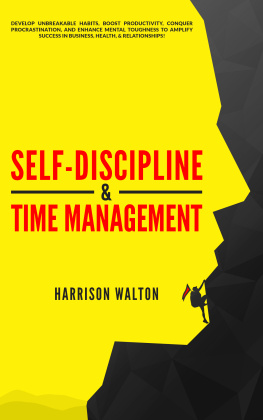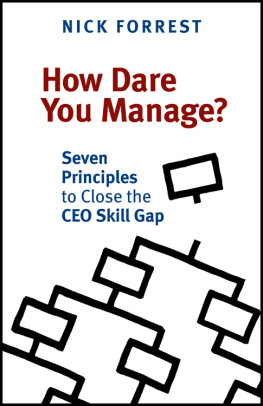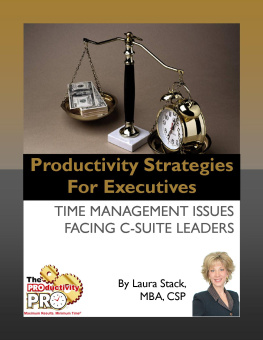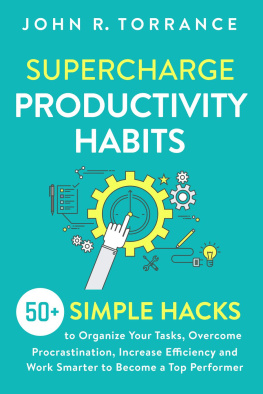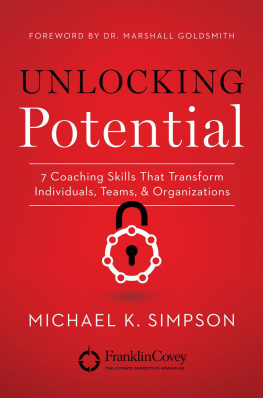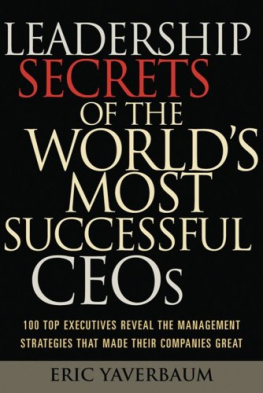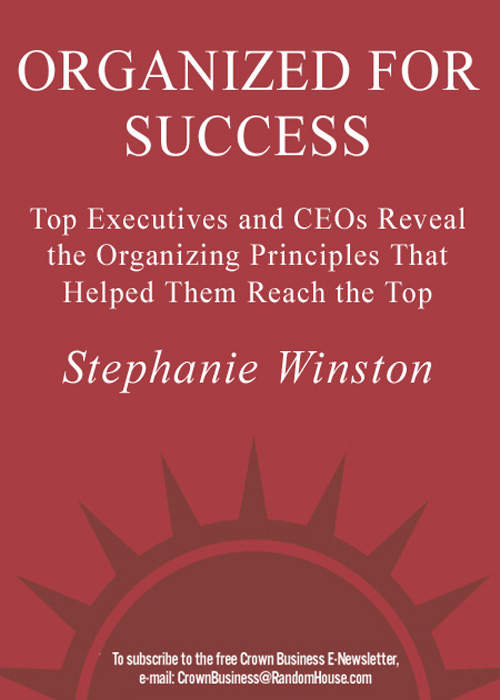

Contents
To the through-thick-and-thin five:
Dinah and Terry, Marnie, Norma and Sanford
Acknowledgments
Its hard to know where to start thanking the many people who have generously given their time, thoughts, and effort on behalf of Organized for Success.
First, of course, are the executives upon whose insights and extraordinary productivity this book rests. Many, many thanks to you for your time, your wisdom, and your genuine interest in sharing your experience. No one had ever asked you these questions before!
Many people very kindly opened executive doors for me, including: Marsha Albert, Julane Borth, Natalie Goldberg, Amy Hohn, Dinah and Fred Lovitch, Hadassah Markson, Karen Page, and Dee Soder.
One of the great privileges of preparing Organized for Success was the exhilarating opportunity to explore and develop ideas with numerous friends and colleagues. These people and their fine minds and wish to support me and Organized for Success contributed more than they know: Marsha Albert, Mark Chimsky, Barry Greisman, Lorie Greisman, Beth Lovitch, Dinah Lovitch, John Tepper Marlin, Karen Page, Terry Pickett, Tom Ranieri, Sanford Schmidt, and Carole Sinclair.
I want to especially thank three people at the heart of this enterprise: my editor, Annik LaFarge, whose unending interest and support, and whose enthusiasm for yet another round of batting around ideas, were exemplary; Nan Bauroth, writer/editor and friend, with great thanks for her major guidance and excellent judgment; and, superlatively, as always, the person who has guided me through more thickets than I can count, my colleague, cousin, and friend Marnie Winston-Macauley.
I would like to make special note of Michele Jaffe, who has prepared and typed this manuscript accurately and tirelessly through its many permutations. A bouquet of thanks. And thanks to Allison Futterman for all her help with admin and correspondence.
Thanks so much to my agent, Carole Sinclair, who launched Organized for Success and has shepherded it all along the way. Many thanks also to the Random House team, including my editor, Annik LaFarge; John Mahaney, executive editor for Crown Business; publicity manager Tara Gilbride; senior publicist Jason Gordon; copy editor David Wade Smith; and director of sales Doug Jones.
Introduction
Early in my career I felt that organization would destroy my creativity. Whereas now, I feel the opposite. Discipline is the concrete that allows you to be creative.
VERNA GIBSON,
former president & CEO
The Limited/Victorias Secret
For the past twenty years I have consulted with businesses both large and small to develop techniques and strategies to help managers and professionals establish organization in an overwhelming work environment. And Ive studied the digitized technologiescomputers, PDAs, voice mail, e-mailto develop ways for people to stay organized in the increasingly fast-paced and often chaotic workplace in which we all find ourselves.
Yet, its all just too much. I hear from managers every day that their corporation is so lean and focused on productivity that they feel as if theyre now required to perform two, or even three, jobs. Theres just so much of me to go around, people often say, revealing the increasing stress caused by workload demands.
One day, an interesting and surprising thought came to me. I suddenly realized that after all the years of consulting with the people who report to the top boss, no CEO who had risen up the ladder of a large organization had ever asked me to assist with their personal time-management and organizational practices.
Yet, they have no more time during the day than you or I do. So I became curious. Surely every manager all the way up the lineincluding CEOsfaces the same fundamental organization and time-management challenges every day, and must deal with them at the warp speed at which most companies now work. So why is it that my services had never been tapped by up-the-ladder CEOs? How do they get so much accomplished in so little time? Is there something they know that we dont? Do they possess distinctive organizing skills and tactics not shared by the rest of us, and which, even in the midst of the digital revolution, have retained special potency? I suspected that many managers and professionals would be interested in finding out about the secrets of time and organizational mastery from executives who have achieved success. I decided to explore this question, and this book is the result.
At the outset I assumed that most senior executives would be functionally organizedotherwise they would not have made it to the top.
What I didnt anticipate, though, is that there is indeed a hidden organizing and time-management story among those who serve in the highest ranks of major organizations. In significant ways they do operate differently from the rest of us. And what is exciting is that their strategies are highly adaptable, in terms of both practical organizational disciplines and underlying mental disciplinesa decidedly strategic mindset rooted in a willingness to make decisions, and mastery of keeping their eyes on the prize.
But Im also here to tell you another thing I discoveredsomething that even with my twenty years of experience in workplace organization I did not expect to find: CEOs who rise through major corporations appear to share, across industry lines, a kind of effectiveness attitude that incorporates six specific action-oriented organizational strategies.
No one has really looked at organization in this way. In this book Ive attempted to distill and quantify these foundational organizing practices of CEOs and superexecutives into practical strategies that will enable you to adapt these executive insights to your own management stylethereby increasing your own potential for success. You want to make a contribution, you want to succeed, and you want to have a life.
This book is also addressed to the manager who wants the next job, who is interested in learning how successful executives used organization and time-management tools in unique ways to help launch themselves to the next level of success, significantly enlarging your ability to be powerful and effective within your own working environment.
My conclusions are based on a combination of interviews and free-ranging discussions with more than forty top executives from every business arena, as well as an extensive review of information from published sources.
The very good news for all of us is that these six fundamental executive practices and disciplines are readily adaptable to the day-to-day time-management programs of managers and executives at every level.
Six Action-Oriented Organizing Strategies
First: Three Facets of Executive Organization and Time Management
1: PERSONAL PRODUCTIVITY PROFILE
This facet of executive organization is about getting out from under and whiz-bang efficiency, solving problems like:
How do I get on top of e-mail overload?
Every time I start tackling my to-do list, a client calls and it gets put off.
It feels like Ive got 900 interruptions every day and Ive got to get my job done! What are some interruption-control strategies?
I go faster and faster every day, but never seem to get my priorities accomplished.
What this book will show you is that simple tactical choiceslining up the tools of productivitycan help you tremendously to accomplish goals. For example, in the chapter on e-mail, I highlight the tactics employed by one manager that reduced the number of e-mail reports he dealt with by 50 percent. Imagine how much more time that gave him to focus on the truly critical tasks at hand, and what a psychological lift he got from getting so much stuff out of his in-box and off his desk.
Next page

